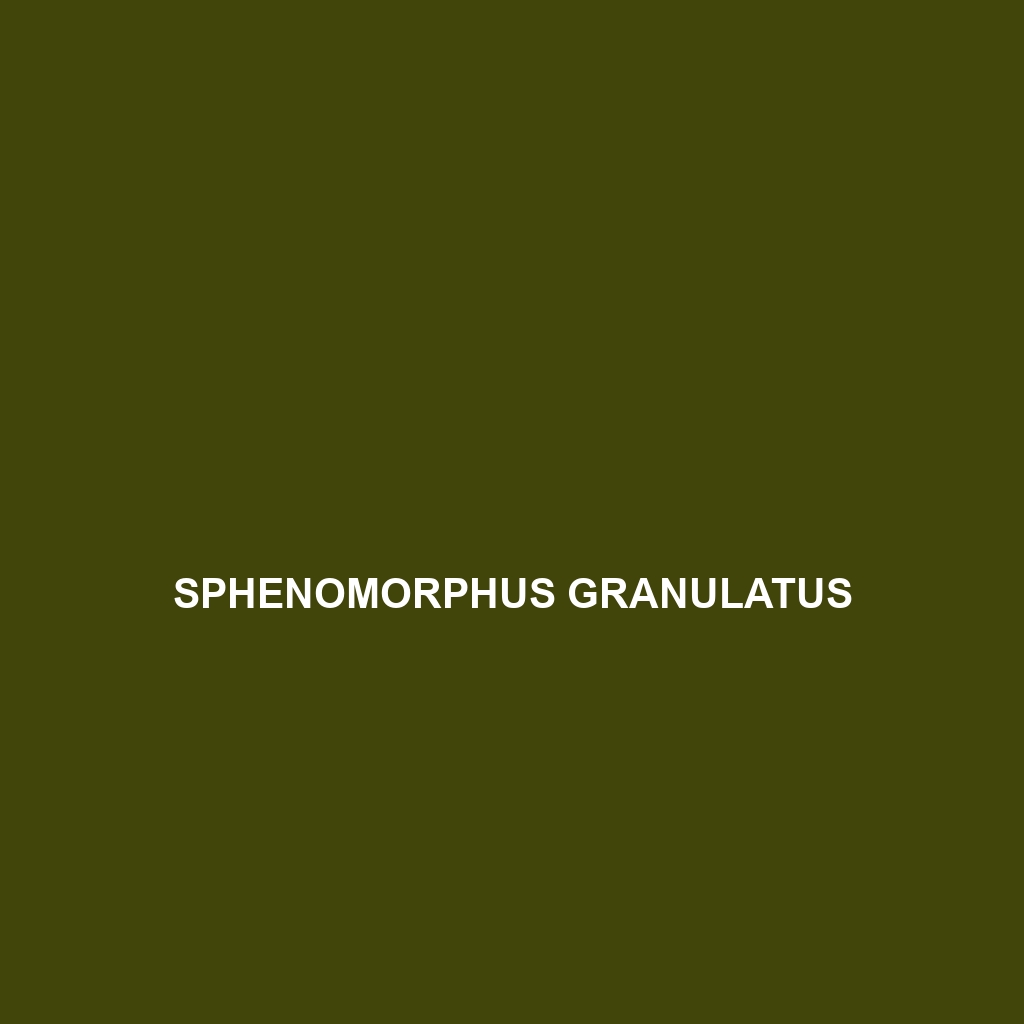Common Name
Sphenomorphus granulatus
Scientific Name
Sphenomorphus granulatus
Habitat
Sphenomorphus granulatus, commonly known as the Granulated Skink, primarily inhabits humid tropical environments. This species is predominantly found in Southeast Asia, particularly in regions of rainforests and temperate forests. These environments provide essential cover and moisture, which are pivotal for the skink’s survival. They thrive in areas with ample leaf litter, underbrush, and decaying wood, where they can find protection and perfect conditions for foraging. The climate in these habitats ranges from mild to warm, with significant rainfall facilitating a rich biodiversity. Their adaptability also allows them to occupy savannas and occasionally venture into nearby marine habitats, particularly in coastal regions.
Physical Characteristics
The Granulated Skink exhibits a slender body shape, typically reaching lengths of up to 10 to 15 cm. Its skin features a distinctive granular texture, which is a key identifying characteristic that gives the species its name. The coloration varies from a deep brown to a lighter tan, often with darker stripes running along the back, providing excellent camouflage against the forest floor. This coloration not only aids in hiding from predators but also helps to absorb heat in cooler conditions. The skink’s limbs are short but powerful, allowing for agile movements through their dense habitat. Their tails are robust, serving both for balance and as a defense mechanism when threatened.
Behavior
Sphenomorphus granulatus displays diurnal activity patterns, meaning they are primarily active during the daytime. They exhibit social behaviors, often seen basking on rocks or fallen logs in small groups. These skinks have unique habits such as burrowing into the leaf litter to escape the heat or evade predators. Their mating rituals are particularly fascinating, as they engage in elaborate courtship displays that involve intricate movements and tail-waving. These behaviors are essential for attracting mates and establishing territory. Additionally, they are known for their defensive actions, such as playing dead or shedding their tails to escape danger.
Diet
The diet of Sphenomorphus granulatus primarily consists of small insects, making this species an insectivore. They feed on a variety of arthropods such as ants, beetles, and small worms. Their foraging behavior is mainly ground-based, where they use their sharp vision to spot prey hiding in leaf litter. During the wet seasons, they may also consume small fruits and foliage, showcasing some omnivorous tendencies. Their feeding patterns are characterized by quick movements, allowing them to capture prey efficiently. This diet plays a crucial role in controlling insect populations in their ecosystem.
Reproduction
The reproductive cycle of Sphenomorphus granulatus typically corresponds with the rainy season, which provides optimal conditions for raising offspring. Mating occurs during the warmer months, and females are known to lay clutches of 2 to 7 eggs in concealed locations, such as under rocks or deep in the leaf litter, ensuring protection from predators. The gestation period lasts about 30 to 60 days, after which the young skinks hatch and are independent. Parental care is minimal, as the young are fully formed and capable of fending for themselves immediately after hatching. This reproductive strategy is common in many skink species, helping to maximize survival chances in their natural habitat.
Conservation Status
The conservation status of Sphenomorphus granulatus is currently classified as least concern by the International Union for Conservation of Nature (IUCN). However, habitat loss due to deforestation and land development poses potential threats to their populations. Conservation efforts are focused on protecting their natural habitats, ensuring the maintenance of healthy ecosystems. Ongoing research is necessary to monitor their populations and adapt conservation strategies as needed.
Interesting Facts
One of the most intriguing aspects of Sphenomorphus granulatus is its ability to mimic the appearance of more dangerous snake species to deter predators. This behavioral adaptation is a fascinating survival technique that adds to their uniqueness. Additionally, these skinks exhibit a remarkable capacity for regeneration, particularly their tails, which can regrow after shedding—a common defense mechanism in reptiles. They have also been observed communicating through body language rather than vocalizations, hinting at a complex social structure.
Role in Ecosystem
Sphenomorphus granulatus plays a vital role in its ecosystem as both a predator and prey species. By consuming large quantities of insects, they help in controlling pest populations, which is essential for maintaining ecological balance. Additionally, as prey, they are part of the food web, supporting various predators. Their presence indicates a healthy ecosystem, and their interactions with plant life contribute to seed dispersal in their habitats. This species exemplifies the interconnectedness of life within the conservation of tropical and temperate forests.
